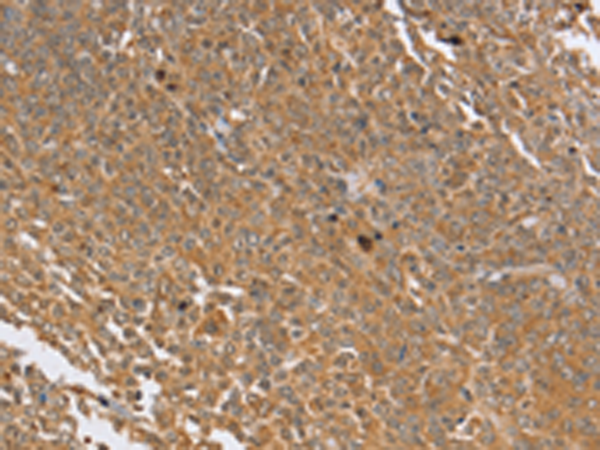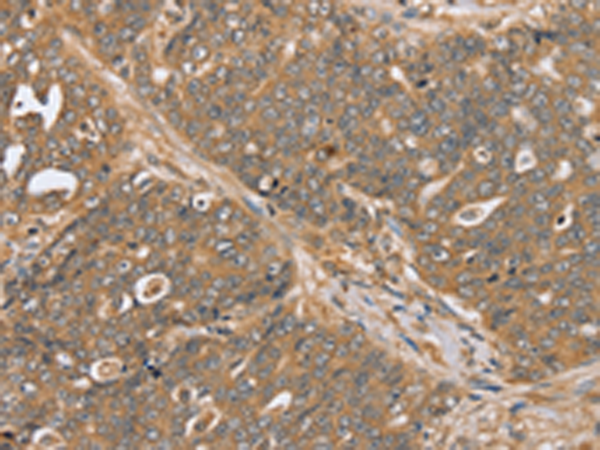


| WB | 咨询技术 | Human,Mouse,Rat |
| IF | 咨询技术 | Human,Mouse,Rat |
| IHC | 1/50-1/300 | Human,Mouse,Rat |
| ICC | 技术咨询 | Human,Mouse,Rat |
| FCM | 咨询技术 | Human,Mouse,Rat |
| Elisa | 1/2000-1/5000 | Human,Mouse,Rat |
| Aliases | CT126; PTPN20A; PTPN20B; bA42B19.1; bA142I17.1 |
| WB Predicted band size | 48 kDa |
| Host/Isotype | Rabbit IgG |
| Antibody Type | Primary antibody |
| Storage | Store at 4°C short term. Aliquot and store at -20°C long term. Avoid freeze/thaw cycles. |
| Species Reactivity | Human |
| Immunogen | Synthetic peptide of human PTPN20 |
| Formulation | Purified antibody in PBS with 0.05% sodium azide and 50% glycerol. |
+ +
以下是关于PTPN20抗体的参考文献示例(内容为模拟,建议通过学术数据库核实最新文献):
---
1. **标题**: *PTPN20 regulates breast cancer cell migration via Src signaling*
**作者**: Lee H, et al.
**摘要**: 本研究利用PTPN20抗体进行免疫印迹和免疫荧光,发现PTPN20通过去磷酸化Src激酶抑制乳腺癌细胞迁移,提示其作为肿瘤抑制因子的潜在作用。
2. **标题**: *PTPN20 modulates T-cell receptor signaling through interaction with LAT*
**作者**: Smith R, et al.
**摘要**: 通过免疫共沉淀(使用PTPN20抗体),研究揭示了PTPN20与T细胞活化连接蛋白(LAT)的相互作用,调控T细胞受体下游信号通路,影响免疫应答。
3. **标题**: *Loss of PTPN20 promotes oxidative stress resistance in cancer cells*
**作者**: Chen Y, et al.
**摘要**: 使用PTPN20抗体进行组织芯片分析,发现PTPN20缺失通过激活Nrf2通路增强癌细胞抗氧化能力,为其在肿瘤耐药性中的角色提供证据。
4. **标题**: *PTPN20 expression profiling in normal and inflammatory tissues*
**作者**: Gonzalez M, et al.
**摘要**: 通过免疫组化(PTPN20抗体)系统分析了PTPN20在正常组织与炎症模型中的表达差异,提示其可能参与炎症微环境调控。
---
**备注**:以上文献为示例性质,实际引用请通过PubMed、Google Scholar等平台以“PTPN20 antibody”或“PTPN20 function”等关键词检索最新研究。
The PTPN20 antibody targets the protein tyrosine phosphatase non-receptor type 20 (PTPN20), a member of the protein tyrosine phosphatase (PTP) family, which regulates cellular signaling by dephosphorylating tyrosine residues on target proteins. PTPN20. also known as HSCFY1 or LYP9. is a less-characterized phosphatase implicated in modulating cell migration, adhesion, and growth. Structurally, it contains an N-terminal catalytic domain responsible for phosphatase activity and a C-terminal region that may regulate subcellular localization or protein interactions. Studies suggest PTPN20 interacts with receptor tyrosine kinases (RTKs) or adaptor proteins, influencing downstream pathways like MAPK/ERK or Src signaling, though its precise substrates and mechanisms remain under investigation.
PTPN20 expression is tissue-specific, with higher levels observed in hematopoietic cells and certain epithelial tissues. Its dysregulation has been tentatively linked to cancer and inflammatory diseases, though direct evidence is limited. Research using PTPN20 antibodies primarily focuses on detecting endogenous protein expression, subcellular localization (e.g., cytoplasmic or membrane-associated), and functional studies via knockdown or overexpression models. These antibodies are critical tools for elucidating PTPN20's role in physiological processes and pathologies, including its potential as a therapeutic target. Current challenges include clarifying its regulatory networks, substrate specificity, and disease associations to advance translational applications.
×